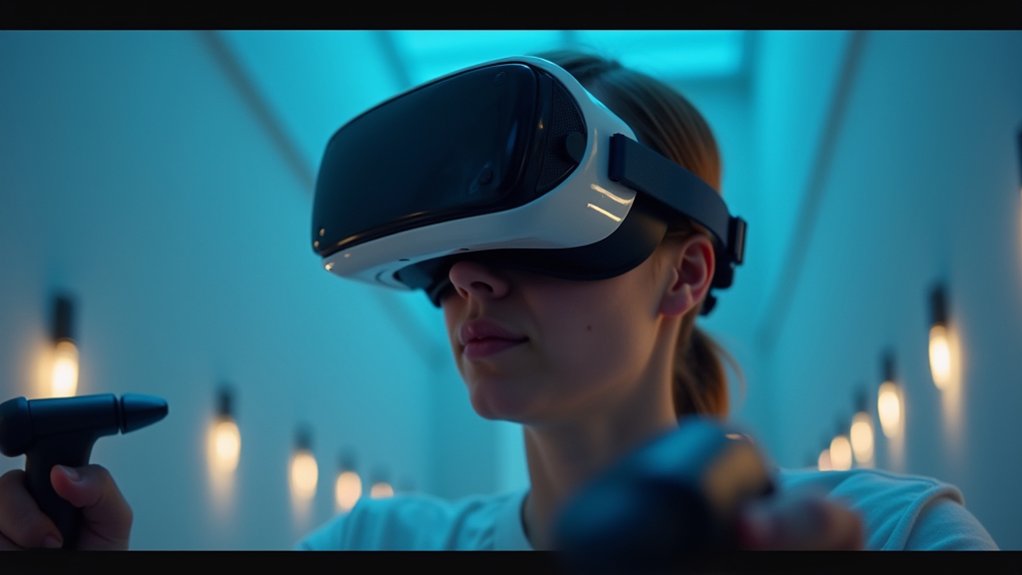
How to complete your crypto transaction?
Start your crypto journey by mastering the first transaction—discover the crucial steps you can't afford to miss before making your move.
When you slip on a VR headset, the immersive experience might make you forget the cutting-edge technology at play. These headsets use advanced sensors and cameras to track your head turns, tilts, and even subtle gestures with impressive accuracy. But how do VR headsets know exactly where you are and what you’re doing? Understanding the magic behind this seamless VR headset tracking can transform the way you experience virtual worlds. Let’s dive into what makes VR headsets so precise and reliable.

By using a combination of sensors, cameras, and algorithms, VR headsets can accurately capture your movements. This technology allows VR headsets to create a lifelike experience that mirrors your every move. Whether you’re gaming, exploring virtual environments, or using VR for training, the precision of VR headsets ensures a smooth and engaging experience.
When you put on a headset, inertial measurement units (IMUs) immediately start working their magic by tracking your movements.
These tiny sensors are key players in the world of technology, as they measure acceleration and rotation to interpret each motion. By using IMUs, your headset can accurately determine if you look up, down, or turn your head.
This seamless data collection ensures that your virtual environment responds smoothly, making every interaction feel natural and immersive.
With IMUs integrated into smartphones, apps, and software, the technology is more accessible than ever, enhancing our digital experiences.
Gyroscopes and accelerometers are essential for tracking movements in modern technology, especially in the world of virtual reality and smartphones.
Gyroscopes play a crucial role by measuring the speed of your head’s rotation, providing precise data on angular velocity. Meanwhile, accelerometers detect changes in speed and direction, allowing devices to sense movement in any direction.
By integrating gyroscope and accelerometer readings, your headset or smartphone can accurately track your orientation and movements, ensuring that your virtual experiences seamlessly mirror your real-world actions.
These key components—gyroscopes and accelerometers—are fundamental in delivering immersive and responsive technology experiences.
Optical tracking systems are a cutting-edge technology that plays a crucial role in enhancing virtual reality experiences.
These systems use cameras and light to accurately determine your headset’s position in space, ensuring seamless integration into the virtual world. By detecting specific markers, such as LEDs or unique patterns on your VR headset or within your environment, the cameras capture precise positions and angles.
This data is then sent to your device, where software calculates your exact location and orientation. By effectively mirroring your movements in the digital realm, optical tracking systems provide an immersive experience.
If you’re interested in exploring the world of virtual reality, understanding how optical tracking systems work is essential. These innovative systems are a testament to the incredible advancements in technology that continue to shape our digital experiences.
Inside-out vs. outside-in tracking methods are the two primary approaches for tracking movements in virtual reality. Both methods offer unique advantages and serve the same purpose, yet they operate quite differently.
Inside-out tracking is a popular choice in the realm of virtual reality technology, as cameras and sensors are integrated directly into your VR headset. This feature allows the headset to map the surrounding environment seamlessly.
On the other hand, outside-in tracking relies on external devices strategically placed in your space. These devices monitor your position and movements, ensuring accurate tracking as long as you remain within their field of view.
Whether you choose inside-out or outside-in tracking, both methods are pivotal in enhancing your virtual reality experience.
Base stations and external sensors are crucial components for many VR systems, ensuring precise and reliable tracking.
By setting up these devices around your play area, they emit signals or detect markers on your VR headset, enhancing your immersive experience. This external setup allows the VR system to pinpoint your position and orientation with impressive accuracy, significantly reducing drift and lag.
As a result, your in-game movements seamlessly match your real-world actions. Investing in quality base stations and external sensors can truly elevate your VR experience, making every gaming session more realistic and enjoyable.
When it comes to VR immersion, tracking controllers and hand movements play a crucial role in enhancing the virtual experience.
Tracking controllers use a combination of cameras, sensors, and sometimes infrared lights to accurately detect your controller’s position and orientation. This technology ensures that your interactions within the virtual world feel natural and intuitive.
Advanced tracking systems even allow for the detection of individual finger movements, giving you the capability to grab, point, or gesture in VR environments as you’d in real life.
Virtual reality (VR) technology has made significant strides in addressing the challenges of latency and motion sickness, which can quickly disrupt the immersive experience.
Headset manufacturers are prioritizing advanced hardware and software solutions to tackle these issues. By implementing high refresh rates, low-persistence displays, and refined sensor fusion, they’re able to offer smoother tracking and quicker response times.
These innovations work in harmony to reduce lag and image blurring, ensuring that users remain comfortable and engaged during extended VR sessions.
With these technological advancements, latency and motion sickness are becoming less of a concern, allowing you to fully enjoy the virtual world.
Virtual reality (VR) is taking a giant leap forward with the latest innovations in eye and facial tracking technology. By significantly reducing latency and motion sickness, VR has already become more comfortable, but the introduction of advanced eye and facial tracking is set to elevate the experience even further.
This groundbreaking technology allows VR headsets to accurately detect where you’re looking and capture the subtle nuances of your facial expressions. The result? Avatars that mirror your emotions and reactions in real time, making virtual interactions feel more personal and authentic.
With advanced eye and facial tracking, you gain a deeper sense of presence within the virtual world, enhancing your overall VR experience. Whether you’re exploring new apps, engaging with software, or diving into the latest smartphone VR advancements, eye and facial tracking are key technologies pushing the boundaries of what’s possible in virtual reality.
As VR technology continues to evolve, you’re on the brink of experiencing a new era in VR movement tracking. This advancement will bring you even closer to the virtual world with precise and responsive tracking capabilities.
Look forward to groundbreaking innovations like full-body tracking without the need for external sensors. This cutting-edge technology will revolutionize the VR movement tracking landscape.
Additionally, AI-driven prediction will ensure smoother interactions, enhancing your virtual experience. The integration of haptic feedback will further blur the lines between reality and the digital realm.
Soon, your natural gestures, micro-movements, and even biometrics will be flawlessly mirrored in VR, making your virtual presence more authentic than ever.
Stay tuned for these exciting developments in VR movement tracking that will redefine how you interact with technology.
Experience the future of movement tracking with headsets that accurately capture your every move. With advanced sensors like IMUs, gyroscopes, accelerometers, and optical tracking, your headset tracks your movements with precision. Whether you’re turning your head, reaching out with a controller, or just glancing around, these technologies ensure your virtual experience remains smooth and lifelike. As eye and facial tracking technology continues to advance, you’ll find yourself even more immersed in VR worlds. The future of movement tracking technology promises even greater realism, comfort, and presence, making your experiences more enjoyable than ever. Keep an eye on the latest advancements in movement tracking for the most immersive virtual experiences.

Start your crypto journey by mastering the first transaction—discover the crucial steps you can't afford to miss before making your move.

How many cryptocurrencies are circulating worldwide today, and what factors are fueling this rapid growth? Discover the surprising answer inside.

Navigating the world of humanoid robot companies isn't easy—discover the seven essential tips you can't afford to overlook before making your choice.

Unlock the secrets of seamless cryptocurrency transactions—understand every crucial step before you risk your first coin. Discover what most beginners miss.

Navigating the vast world of cryptocurrencies, you’ll notice the total number keeps changing—curious what’s causing these endless shifts?

Here are the most secure platforms to buy cryptocurrency online—discover which one keeps your assets safest before you make your next move.